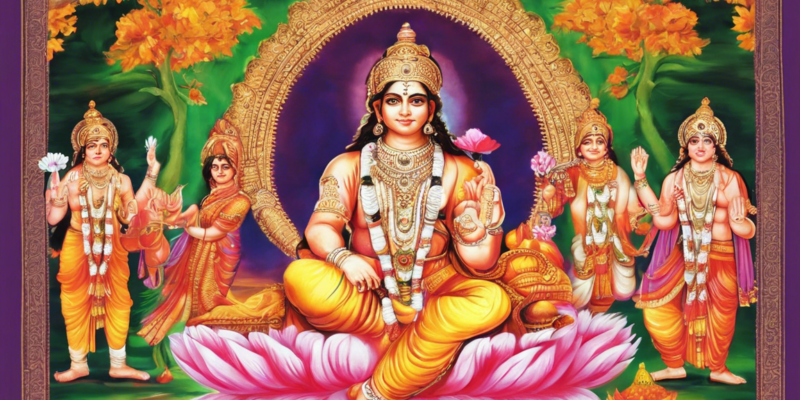The Bhagavad Gita, often referred to as the Gita, is a 700-verse Hindu scripture that is part of the Indian epic Mahabharata. It consists of a conversation between Prince Arjuna and the god Krishna, who serves as his charioteer. The Gita addresses the moral and philosophical dilemmas faced by Arjuna on the battlefield of Kurukshetra, where he is filled with doubt and moral confusion about fighting in the war.
Chapter 1 of the Bhagavad Gita, known as Arjuna Vishada Yoga or The Yoga of Arjuna’s Dejection, sets the stage for the epic dialogue between Arjuna and Krishna. In this chapter, Arjuna surveys the battlefield and is overcome with doubt, dejection, and compassion for his relatives who are fighting on both sides of the war.
Summary of Shrimad Bhagavad Gita Chapter 1:
- The chapter begins with Prince Dhritarashtra inquiring about the events on the battlefield from his charioteer, Sanjaya.
- Sanjaya narrates the situation to Dhritarashtra, describing the armies arrayed for battle and the mighty warriors on both sides.
- Arjuna, guided by Krishna, instructs his charioteer to place their chariot between the two armies so that he can survey the warriors he must face in battle.
- As Arjuna sees his relatives, teachers, and friends on both sides of the battlefield, he is filled with sorrow and compassion. He lays down his bow and refuses to fight.
- Arjuna expresses his concerns to Krishna, confessing his inner turmoil and the moral dilemma he faces in fighting his own kin.
- Arjuna fears the destruction of family traditions and the sins that will result from the war. He is torn between his duty as a warrior and his love for his family.
This opening chapter of the Bhagavad Gita sets the stage for the profound teachings that Krishna imparts to Arjuna in the subsequent chapters. It highlights the human experience of conflict, self-doubt, and the search for meaning and purpose in life.
Key Themes in Chapter 1 of the Bhagavad Gita:
-
Dharma and Duty:
Arjuna grapples with the concept of dharma, or duty, as he faces the moral dilemma of fighting in a war against his own family members. The chapter explores the complexities of fulfilling one’s responsibilities in the face of personal and ethical challenges. -
Emotional Turmoil:
Arjuna’s emotional turmoil and inner conflict reflect universal human experiences of doubt, fear, and compassion. His struggle resonates with readers who navigate similar dilemmas in their lives. -
Family and Relationships:
The chapter delves into the complexities of familial and social relationships. Arjuna’s reluctance to harm his loved ones highlights the bonds of kinship and the tensions that arise when duty clashes with personal attachments.
Lessons from Shrimad Bhagavad Gita Chapter 1:
-
Clarity Amidst Confusion:
Krishna’s guidance to Arjuna demonstrates the importance of seeking clarity and wisdom in moments of confusion and crisis. By turning to a higher power or inner wisdom, one can navigate life’s challenges with more insight and confidence. -
Duty and Sacrifice:
The chapter underscores the themes of duty, sacrifice, and selflessness. Arjuna’s hesitation to fight serves as a reminder of the sacrifices often required to uphold one’s principles and fulfill one’s responsibilities. -
Mindfulness and Compassion:
Arjuna’s compassion for his loved ones, even in the midst of conflict, highlights the significance of empathy and mindfulness in times of adversity. By cultivating compassion, individuals can approach conflicts with a more open heart and understanding.
Frequently Asked Questions (FAQs) about Shrimad Bhagavad Gita Chapter 1:
- Where can I download the PDF of Shrimad Bhagavad Gita Chapter 1?
-
Shrimad Bhagavad Gita Chapter 1 PDFs are available on various websites dedicated to Hindu scriptures and spiritual texts. You can search for trusted sources to download the chapter for offline reading.
-
What is the significance of Arjuna’s dejection in Chapter 1 of the Bhagavad Gita?
-
Arjuna’s dejection symbolizes the human experience of doubt, confusion, and moral dilemmas. It sets the stage for the philosophical teachings that Krishna imparts to guide Arjuna towards clarity and right action.
-
How does Arjuna’s inner conflict relate to everyday life challenges?
-
Arjuna’s inner conflict mirrors the dilemmas individuals face in balancing personal desires with moral responsibilities, familial expectations with individual choices, and emotional attachments with higher principles. It resonates with the complexities of navigating life’s challenges.
-
What are the key takeaways from Arjuna Vishada Yoga, Chapter 1 of the Bhagavad Gita?
-
The chapter emphasizes the themes of duty, sacrifice, emotional turmoil, and the importance of seeking clarity and guidance in times of confusion. It offers insights into navigating moral dilemmas, honoring responsibilities, and cultivating compassion amidst conflicts.
-
How does Krishna’s counsel to Arjuna in Chapter 1 set the stage for the teachings of the Bhagavad Gita?
- Krishna’s guidance to Arjuna lays the foundation for the spiritual teachings and philosophical discourse that unfold in the subsequent chapters of the Bhagavad Gita. By addressing Arjuna’s doubts and fears, Krishna prepares him for the deeper wisdom he is about to impart.
In conclusion, Shrimad Bhagavad Gita Chapter 1, Arjuna Vishada Yoga, invites readers to reflect on the complexities of human emotions, ethical dilemmas, and the quest for inner clarity. It sets the tone for the enlightening dialogue between Arjuna and Krishna, offering timeless lessons on duty, compassion, and the pursuit of truth amid life’s challenges.


Comments